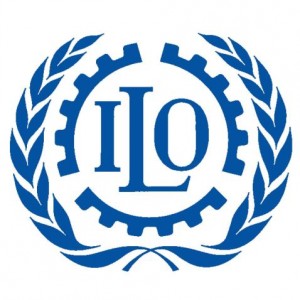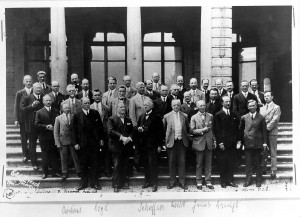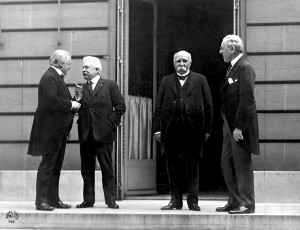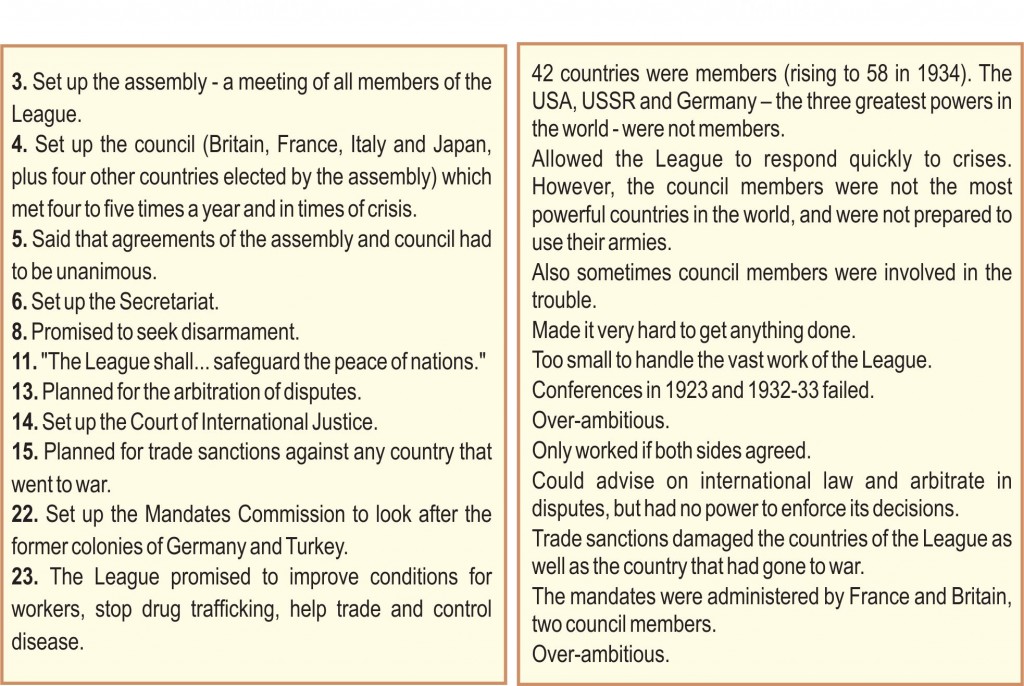League of Nations
Purpose, Successes and Failures
Muhammad Rashid
Introduction
The League of Nations was an international organization, headquartered in Geneva, Switzerland. It was created after the First World War on January 10, 1920, at the initiative of the victorious Allied powers of World War I. It provided a forum for resolving international disputes, issues and problems through negotiations and discussions.
Origin
The League of Nations has its origins in the Fourteen Points speech of President Woodrow Wilson, part of a presentation given in January 1918 outlining of his ideas for peace after the carnage of World War I. Wilson envisioned an organization that was charged with resolving conflicts before they exploded into bloodshed and warfare. Though first proposed by President Woodrow Wilson as part of his Fourteen Points plan for an equitable peace in Europe, the United States never became a member.
Organizational Structure
Secretariat: Permanent civil service of the League which carried out decisions taken by the Council
Assembly: All nations are equal – one country, one vote. Decisions were taken unanimously. It met once a year
Council: Super powers were its members and they took major decisions.
Permanent Court of Justice: For the settlement of international disputes. 15 judges met at the Hague in the Netherlands
International Labour Organization: Each member state sent two government ministers, one employer and one worker for discussing working conditions in states for the improvement of working conditions.
Special Commissions
- Drug addiction
- Health
- Minorities
- Refugees
- Women
- Slavery
- Mandates
- Help for underdeveloped nations
- Economic and Financial Organization
- Transit, Transport and Communications
- International Committee on Intellectual Cooperation
- Permanent Central Opium Board
- m. Advisory Committee on the Traffic in Women and Children
- Disarmament Commission
- Committee for the Study of the Legal Status of Women
Aims & Objectives
- To stop wars and make world a better place to live
- To improve peoples’ lives, create jobs, improve public health and end slavery
- To work for disarmament
- To enforce Treaty of Versailles
Powers
Covenant: All members promised and obliged to keep peace according to Article 10 of covenant
Condemnation: The leagues had authority to condemn any wrongdoing of states either at global level or at the platform of its assembly
Arbitration: League had authority to decide issues, disputes and problems among nations
Sanctions: League had authority to implement sanctions on any state against its violation of Covenant of the league or international law. Sanctions may be economic, military or social boycott.
Why League of Nations Failed?
The League died in 1935. On day it was a powerful body imposing sanctions, the next day, it was a useless fraud, everybody running away from it as quietly as possible. Hitler watched.
— AJP Taylor 1966
- Forty-two countries joined the League at the start. In the 1930s about 60 countries were members. This made the League seem strong. However, the most powerful countries in the world were not members.
- The absence of world superpower to join the League seriously damaged its authority to deal with international issues. The US Congress did not approve Wilson’s proposal for the formation of the League.
- The defeated power of WWI were not consulted and invited regarding formation and joining of the League of the Nations.
- The idealism of Wilson and his belief on cooperation among nations were not shared by the cynical and worldly-wise European nations. UK favoured League just for Wilson’s pleasure while France agreed on the basis of additional security benefits against Germany.
- The organizational structure of the League was a muddle.
- After WWI, Vilna – an area claimed by both Lithuania and Poland – was part of Lithuania but it had majority Polish population. During the Russo-Polish War of 1920, Poland took over the Vilna and refused to return. League was reluctant to take any action against Poland because France and UK considered it a strong barrier against Russian and German expansion. They didn’t want to disturb it. Other members refused to use military force against Poland and tried to negotiate, but in 1923 the League declared Vilna a part of Poland.
- By the Washington Naval Agreement of 1922, the USA, UK, France and Italy agreed to limit their fleets. No major ships were to be built for ten years.
- Inability of the League to took any actions against superpowers, e.g. Japanese attack on Manchuria, conflict of Italy on Ethiopia and Greece, and in the case of armament of German, France and UK.
- League failed to resolve international disputes. For example:
- In Greece, an Italian officer, who was there for some official duty of the League, was killed. In return, Mussolini attacked and captured an important place in Greece, i.e. Corfu in 1923. Greece approached the League for resolution of the matter. League ordered Italy to withdraw from Corfu but Mussolini refused. The League, surprisingly, tried to persuade Greece to pay compensation and seek apologies from Italy. Greek did as Mussolini demanded.
- Poland ignored the League’s decision when it took some places form Russia.
- Kellogg Briand Pact of 1928 (or Pact of Paris, officially General Treaty for Renunciation of War as an Instrument of National Policy) wherein signatory states promised not to use war to resolve “disputes or conflicts of whatever nature or of whatever origin they may be, which may arise among them,” also indicates the ignorance of the League – a large number of nations signed a treaty without participation of league.
- When Germany refused to pay reparation, France and UK attacked and made Germany pay. League did nothing in this case too.
- The Great Depression of 1930s had global effects. Japan tried to overcome economic pressure by building and empire. So, in 1932, it invaded Manchuria (China), and established its own government there. The League took two years to think about this issue and order Japan to withdraw its forces from Manchuria, but Japan left the League and paid no heed to its decision.
- In 1935, Ethiopia (Abyssinia) was conquered by Italy. Even though the League imposed sanctions against Italy on rubber and metal trade, and also banned weapons sales to Italy, it was handed over to Italy secretly by France and Britain.
Success and Achievements
- First organization in the world in which governments of states worked for collective security and universal peace and harmony.
- Formation of Disarmament Commission, and, in 1932, Disarmament Conference was set up. But due to Nazism in Germany and fascism in Italy, this effort was jeopardized which led France to armament to counter these threats.
- League successfully resolved issues like:
- Some Greek soldiers were killed in a fight on the Bulgarian-Greek border. In return, Greece invaded Bulgaria. The League condemned Greece and ordered it to leave Bulgaria. In this incidence, Bulgaria did not use its military force against Greece in 1925.
- Aaland Island was a disputed territory between Finland and Sweden. Both the nations went to the League for resolution of the dispute. League intervened and awarded the island to Finland. Sweden accepted the decision.
- League freed approximately 200,000 slaves from Africa and Greece
- Half a million prisoners of war were brought back by the League
- League closed four big companies of drug production
- League set up camps and fed Turkish refugees in 1922
- League sent economic experts to Austria and Hungary for revival of economy as both the nations went could have gone bankrupt if no timely decisions were taken.
- League worked to prevent malaria and leprosy
Did you know?
Allama Muhammad Iqbal predicted the demise of the League of Nations and condemned its devilish character in his poem Jamiat-e-Aqwam (League of Nations):
The League appears to be in death’s tight grips,
I fear this grim news may escape my lips.
The Fate of League to all is plain and clear
But Church. Guides pray that safely it may steer.
On Frank’s dear mistress, may remain alive,
By Satans charm a Few days more survive.
The Covenant of the League of Nations
The League of Nations was set up by the first 26 clauses of the Treaty of Versailles –
called ‘The Covenant of the League of Nations’. The table below is a summary.
 Jahangir's World Times First Comprehensive Magazine for students/teachers of competitive exams and general readers as well.
Jahangir's World Times First Comprehensive Magazine for students/teachers of competitive exams and general readers as well.







